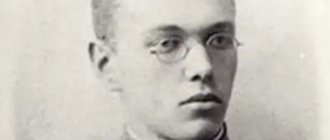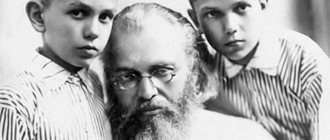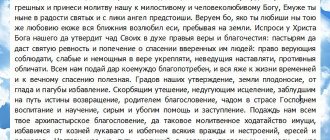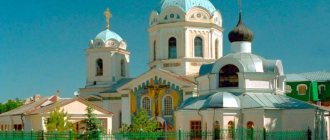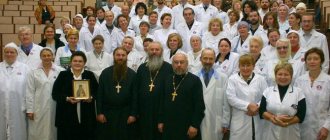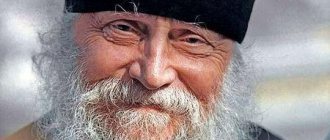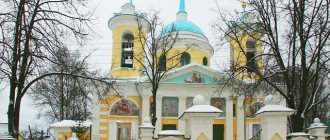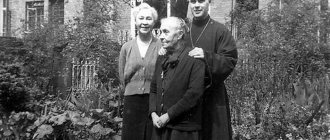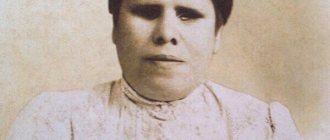| Archbishop of Simferopol and Crimea Luka (Voino-Yasenetsky) |
Luke (Voino-Yasenetsky)
(1877 - 1961), Archbishop of Simferopol and Crimea, holy confessor Memory of March 5 - the discovery of relics in 1996 [1], May 29, in the Councils of New Martyrs and Confessors of the Russian Church, Arkhangelsk, Voronezh, Krasnoyarsk, Crimea, Kursk, Rostov-Yaroslavl saints
In the world, Valentin Feliksovich Voino-Yasenetsky, was born on April 27, 1877 [2] in Kerch, in the family of pharmacist Felix Stanislavovich and his wife Maria Dmitrievna Voino-Yasenetsky. His father was a zealous Catholic, often went to church and prayed for a long time at home, but did not force his family to accept Catholicism. Maria Dmitrievna was Orthodox by birth, although she did not go to church, she prayed at home. According to the laws of the Russian Empire, children in such families had to be raised in the Orthodox faith. Valentin was the third of five children.
His parents soon moved to Kyiv, where in 1896 he simultaneously graduated from the 2nd Kyiv Gymnasium and the Kiev Art School. The young man showed artistic talent, and a direction imbued with a religious idea emerged. Valentin went to churches and to the Kiev Pechersk Lavra, made many sketches of pilgrims, for which he received a prize at an exhibition at the school. He was going to enter the Academy of Arts, but the desire to bring direct benefit to the people forced him to change his plans.
Valentin Feliksovich studied for a year at the Faculty of Law, then moved to the Faculty of Medicine at Kyiv University.
He studies brilliantly. “In the third year,” he writes in “Memoirs,” “an interesting evolution of my abilities took place: the ability to draw very subtly and the love of form turned into a love of anatomy...”
In 1903 he graduated from the university with honors. Despite the entreaties of his friends to take up science, he announced his desire to be a “peasant”, zemstvo doctor all his life, to help poor people.
In January 1904, during the war with Japan, he was sent with the Red Cross hospital to the Far East and worked in Chita as the head of the surgical department of the hospital. Here Valentin Feliksovich met sister of mercy Anna Lanskaya, whom the wounded called the “holy sister,” and married her.
| Valentin Feliksovich Voino-Yasenetsky, around 1910. Photo from fond.ru |
From 1905 to 1917
worked as a zemstvo doctor in hospitals in the Simbirsk, Kursk, Saratov and Vladimir provinces and practiced in Moscow clinics. During this time, he performed many operations on the brain, organs of vision, heart, stomach, intestines, bile ducts, kidneys, spine, joints, etc. and introduced a lot of new things into surgical techniques. In 1908, he came to Moscow and became an external student at the surgical clinic of Professor P. I. Dyakonov. During the First World War, a religious feeling awakened in him, which had been forgotten behind a lot of scientific work, and he began to constantly go to church.
In 1916, he defended his dissertation in Moscow on the topic: “Regional anesthesia,” about which his opponent, the famous surgeon Martynov, said: “We are accustomed to the fact that doctoral dissertations are usually written on a given topic, with the aim of obtaining higher appointments in the service, and their scientific value is low. But when I read your book, I got the impression of the singing of a bird that cannot help but sing, and I highly appreciated it.” Received a Doctor of Medicine degree. The University of Warsaw awarded his dissertation a major Hajnicki Prize.
In 1917, through a competition, he received the position of chief physician and surgeon of the Tashkent hospital, and teaches at the medical school, which was later transformed into the Faculty of Medicine.
In 1919, his wife died of tuberculosis, leaving four children: Mikhail, Elena, Alexei and Valentin.
Valentin Voino-Yasenetsky was one of the initiators of the organization of Tashkent University and in 1920 he was elected professor of topographic anatomy and operative surgery at this university. Surgical art, and with it the fame of Prof. Voino-Yasenetsky's numbers were increasing. In various complex operations, he sought out and was the first to apply methods that later received universal recognition. His former students told wonders about his amazing surgical technique. Patients came to his outpatient appointments in a continuous stream.
He himself increasingly found consolation in faith. He attended the local Orthodox religious society, studied theology, became closer friends with the clergy, and took part in church affairs. As he himself said, he once spoke at a diocesan congress “on one very important issue with a big heated speech.” After the congress, Tashkent Bishop Innokenty (Pustynsky) told him: “Doctor, you need to be a priest.” “I had no thoughts about the priesthood,” recalled Vladyka Luke, “but I accepted the words of His Grace Innocent as God’s call through the bishop’s lips, and without thinking for a minute: “Okay, Vladyka! I will be a priest if it pleases God!”
| Bishop Luke. 1923 Photo from fond.ru |
Ordination
On February 7, 1921, he was ordained a deacon, on February 15, a priest, and appointed junior priest of the Tashkent Cathedral, while also remaining a university professor. In the priesthood, he never ceases to operate and lecture. In October 1922, he actively participated in the first scientific congress of doctors of Turkestan.
The wave of renovationism of 1923 reached Tashkent. Bishop Innokenty (Pustynsky) left the city without transferring the department to anyone. Then Father Valentin, together with Archpriest Mikhail Andreev [3], took over the management of the diocese, united all the remaining faithful priests and church elders, and organized a congress with the permission of the GPU.
In May 1923 he became a monk with a name in honor of St. Apostle and Evangelist Luke, who, as you know, was not only an apostle, but also a doctor and an artist.
Bishop of Tashkent and Turkestan
On May 12 [4] 1923, he was secretly consecrated Bishop of Tashkent and Turkestan in the city of Penjekent by Bishop Daniel of Bolkhov and Bishop Vasily of Suzdal. The exiled priest Valentin Sventsitsky was present at the consecration.
Arrest and exile
On June 10, 1923, he was arrested as a supporter of Patriarch Tikhon. He was charged with an absurd charge: relations with the Orenburg counter-revolutionary Cossacks and connections with the British. In the prison of the Tashkent GPU, he completed his, which later became famous, work “Essays on Purulent Surgery.”
In August he was sent to the Moscow GPU.
In Moscow, Vladyka received permission to live in a private apartment. He served liturgy with Patriarch Tikhon in the Church of the Resurrection of Christ in Kadashi. His Holiness confirmed the right of Bishop Luke of Turkestan to continue practicing surgery.
In Moscow, bishop. Luka was arrested again and placed in Butyrskaya and then in Taganskaya prison, where he suffered from a severe flu. By December, the East Siberian stage was formed, and Bishop Luka, together with Archpriest Mikhail Andreev, were sent into exile to the Yenisei. The path lay through Tyumen, Omsk, Novonikolaevsk (now Novosibirsk), Krasnoyarsk. The prisoners were transported in Stolypin carriages, and they had to travel the last part of the journey to Yeniseisk - 400 kilometers - in the bitter cold of January on a sleigh. In Yeniseisk, all the churches that remained open belonged to the “Living Church,” and the bishop served in the apartment. He was allowed to operate. At the beginning of 1924, according to a resident of Yeniseisk, Bishop Luka transplanted calf kidneys to a dying man, after which the patient felt better. But officially the first such operation is considered to be the transplantation of a pig kidney into a woman suffering from uremia, carried out by Dr. I. I. Voron in 1934.
| Bishop Luke. Tashkent, NKVD prison. 1937 Photo from fond.ru |
Second arrest
In March 1924, he was arrested again and sent under escort to the Yenisei region, to the village of Khaya on the Chuna River. In June he returns to Yeniseisk again, but is soon followed by deportation to Turukhansk, where he serves, preaches and operates.
In January 1925, he was sent to Plakhino, a remote place on the Yenisei beyond the Arctic Circle, and in April he was transferred again to Turukhansk.
All the numerous churches in the city of Yeniseisk, where he lived, as well as the churches in the regional city of Krasnoyarsk, were captured by the renovationists. Bishop Luke, with three priests accompanying him, celebrated the liturgy in his apartment, in the hall, and even ordained priests there who came hundreds of miles away to the Orthodox bishop.
At the end of his exile, he returns to Tashkent, settles in a house on Uchitelskaya Street and serves in the church of St. Sergius of Radonezh.
Bishop of Tashkent and Turkestan (repeat)
On January 25, 1925, he was reappointed to the Tashkent and Turkestan department.
Bishop of Yeletsky
From October 5 to November 11, 1927 - Bishop of Yeletsky, vicar of the Oryol diocese.
From November 1927 he lived in the Krasnoyarsk Territory, then in the city of Krasnoyarsk, where he served in a local church and worked as a doctor in a city hospital.
| Bishop Luke. Tashkent, NKVD prison. 1939 Photo from fond.ru |
Third arrest
On May 6, 1930, he was arrested in connection with the death of Ivan Petrovich Mikhailovsky, a professor at the Faculty of Medicine in the Department of Physiology, who shot himself while insane. On May 15, 1931, after a year of imprisonment, a sentence was passed (without trial): exile to three years in Arkhangelsk.
In 1931-1933 he lived in Arkhangelsk, treating patients on an outpatient basis. Vera Mikhailovna Valneva, with whom he lived, treated patients with homemade ointments from the soil - cataplasms. Vladyka became interested in the new method of treatment, and he applied it in the hospital, where he got Vera Mikhailovna to work. And in subsequent years he conducted numerous studies in this area.
In November 1933, the bishop did not accept the offer of Metropolitan Sergius (Stragorodsky) to occupy the vacant episcopal see. After spending a short time in Crimea, the bishop returned to Arkhangelsk, where he received patients, but did not operate.
In the spring of 1934 he visited Tashkent, then moved to Andijan, operated and lectured. Here he falls ill with papatachi fever, which threatens loss of vision; after an unsuccessful operation, he becomes blind in one eye. He performs church services and heads the department of the Tashkent Institute of Emergency Care.
In the same year, it was finally possible to publish “Essays on Purulent Surgery.” “Perhaps there is no other book like this,
— wrote candidate of medical sciences V.A.
Polyakov, - which would have been written with such literary skill, with such knowledge of the surgical field, with such love for the suffering person.”
Fourth arrest
December 13, 1937 - new arrest. In prison, the bishop is interrogated by an assembly line (13 days without sleep), with the requirement to sign protocols. He goes on a hunger strike (18 days) and does not sign protocols. A new deportation to Siberia follows.
From 1937 to 1941 he lived in the village of Bolshaya Murta, Krasnoyarsk region.
The Great Patriotic War began. In September 1941, Vladyka was taken to Krasnoyarsk to work at the local evacuation center, a health care facility consisting of dozens of hospitals designed to treat the wounded.
Archbishop of Krasnoyarsk
He was elevated to the rank of archbishop.
On December 27, 1942 he was appointed to the Krasnoyarsk department.
On September 8, 1943, he took part in the Council of the Russian Orthodox Church.
At the end of 1943 he moved to Tambov. Although his vision began to noticeably deteriorate, he is actively working in evacuation hospitals, giving reports, giving lectures for doctors, teaching them in word and deed.
| Archbishop of Tambov Luka (Voino-Yasenetsky). 1945 |
Tambov Archbishop
In January 1944 he was appointed Archbishop of Tambov and Michurinsky. He continues his medical work: he has 150 hospitals under his care.
| St. Luka Krymsky. Russian icon (X century) |
During the stay of the archbishop. Luke in Tambov includes a page of memories about him by V.A. Polyakova. He writes: “One Sunday in 1944, I was called to Tambov for a meeting of the heads and chief surgeons of hospitals in the Voronezh Military District.
At that time, I was the leading surgeon at a 700-bed hospital in Kotovsk. A lot of people gathered for the meeting. Everyone took their seats and the presiding chair stood up at the presidium table to announce the title of the report.
But suddenly, both doors opened wide, and a huge man with glasses entered the hall. His gray hair fell to his shoulders. A light, transparent, white lace beard rested on his chest. The lips under the mustache were tightly compressed. Large white hands fingered black matte rosaries.
The man slowly entered the hall and sat down in the first row. The chairman approached him with a request to take a place on the presidium. He got up, walked onto the stage and sat down in the chair offered to him.
This was Professor Valentin Feliksovich Voino-Yasenetsky.
[5].
At the end of 1943, the second edition of “Essays on Purulent Surgery” was published, revised and almost doubled in size, and in 1944 the book “Late Resections of Infected Gunshot Wounds of the Joints” was published.
There is information that he was a member of the Academy of Medical Sciences. However, there is no information about this in official biographies.
In addition to works on medical topics, Archbishop. Luke composed many sermons and articles of spiritual, moral and patriotic content.
From January 31 to February 2, 1945, he participated in the work of the Local Council of the Russian Orthodox Church.
In 1945-1947 he worked on a large theological work - “Spirit, Soul and Body” - in which he developed the question of the soul and spirit of man, as well as the teaching of Holy Scripture about the heart as an organ of knowledge of God. He also devoted a lot of time to strengthening parish life. In 1945, he expressed the idea of the need to elect a patriarch by lot.
In 1945-1947, he completed work on the essay “Spirit, Soul and Body,” which he began in the early 20s.
Archbishop of Simferopol and Crimea
| St. Luke of Simferopol. Greek icon |
In May 1946 he was appointed Archbishop of Simferopol and Crimea.
In Simferopol, he published three new medical works, but his vision was getting worse. His left eye had not seen light for a long time, and at that time a cataract, complicated by glaucoma, began to mature on his right eye.
In 1958, Archbishop Luke became completely blind. However, as Archpriest Evgeny Vorshevsky recalls, even such an illness did not prevent the bishop from performing divine services. Archbishop Luke entered the church without outside help, venerated the icons, read liturgical prayers and the Gospel by heart, anointed them with oil, and delivered heartfelt sermons. The blind archpastor also continued to rule the Simferopol diocese for three years and sometimes receive patients, astonishing local doctors with unmistakable diagnoses. He left practical medical practice back in 1946, but continued to help patients with advice. He ruled the diocese until the very end with the help of trusted persons. In the last years of his life, he only listened to what was read to him and dictated his works and letters.
Died on June 11, 1961. He was buried in the city cemetery of Simferopol.
The most contradictory reviews were given about the character of Archbishop Luke. They talked about his calmness, modesty and kindness, and at the same time, about his arrogance, imbalance, arrogance, and painful pride. One might think that a person who lived such a long and difficult life, saturated to the limit with the most diverse impressions, could manifest himself in different ways. It is quite possible that his enormous authority in the field of surgery, his habit of unconditional obedience to others, especially during operations, created in him intolerance to other people's opinions, even in cases where his authority was not at all indisputable. Such intolerance and domineering could be very difficult for others. In a word, he was a man with the inevitable shortcomings of every person, but at the same time persistent and deeply religious. It was enough to see how soulfully, with tears, he performed the liturgy to be convinced of this.
Having taken up theological sciences at the age of over forty, Archbishop. Luke, naturally, could not achieve such perfection in this area as in medicine; or what some other bishops achieved, devoting their entire lives only to theology. He makes mistakes, sometimes quite serious ones. In his main theological work “Spirit, Soul and Body” there are very controversial opinions, and the article “On John the Baptist sending disciples to the Lord Jesus Christ with the question whether He is the Messiah” was generally banned and not published. But his sermons, to which the Bishop attached exceptional importance, considering them an integral part of the divine service, are distinguished by simplicity, sincerity, spontaneity and originality.
| Relics of St. Luke of Crimea in the Holy Trinity Cathedral in Simferopol |
Reverence
In November 1995, by Decree of the Holy Synod of the Ukrainian Orthodox Church, Archbishop Luke was canonized as a locally revered saint. And on March 20, 1996, in Simferopol, the relics of St. Luke were transferred from the cemetery at the All Saints Church in a procession to the Holy Trinity Cathedral. From now on, every morning, at 7 o’clock, an akathist to the Saint is performed at his shrine in the Holy Trinity Cathedral of Simferopol.
July 2, 1997 in Simferopol, the city where the saint lived in 1946-1961. A monument was unveiled to him.
In August 2000, at the Council of Bishops of the Russian Orthodox Church, he was canonized for church-wide veneration.
Many cases of healing after prayer to St. Luke have been documented. In 2001, a silver shrine was brought from Greece for his relics - the Greeks honor the Crimean saint, many people were healed there through prayers to him. Currently, many churches in the name of St. Luke have been opened in Ukraine, Russia, and Greece.
In 2022, his name was included in the list of the Cathedral of Saints of the Archangel Metropolis [6].
| St. Luke (Voino-Yasenetsky), icon |
Prayers
Troparion, tone 1
To the herald of the path of salvation, / unshakable confessor, / true keeper of fatherly traditions, / teacher of Orthodoxy, / archpastor of the Crimean lands, / godly physician, St. Luke, / Christ the Savior We pray unceasingly, // to grant our souls great mercy.
Kontakion, voice of the same
Like an all-bright star, / in the night of godlessness you shone with virtues / and, having suffered much from persecutors, / you remained unshakable in faith, / adorned with medical wisdom, / many people you healed./ For this reason we cry out to you with love:/ Rejoice, virtuous confessor ,/ Rejoice, Father Saint Luke,// Rejoice, praise and affirmation of the Russian land.
Priesthood and monasticism of Saint Luke
The Lord prepared for him a sorrowful and narrow path leading to the Kingdom of Heaven. At the age of 21 he was ordained a priest. But the priest continued to work in the hospital and perform operations. He came to his workplace in a cassock and with a cross, without fear of persecution by the Bolsheviks. Before the operation, he always prayed fervently in front of the icon, which he hung in the operating room.
In the year 23, he was secretly tonsured a monk in his own home, and then appointed Bishop of Turkestan. His new name became Luke, in honor of the apostle and doctor.
To accept monasticism and holy orders during the years of terrible persecution of the Church was tantamount to suicide. But Luke was not embarrassed to walk everywhere in a cassock and with a cross. He openly invited fire on himself.
Proceedings
Basic medical works
- "Neuromatous elephantiasis of the face, plexiform neuroma." "Surgery", 1908.
- “On methods of anesthesia that are most convenient in zemstvo practice.” "Medical newspaper", 1908.
- "A case of retrograde strangulation of an intestinal loop in an inguinal hernia." "Surgery", 1908.
- "Regional anesthesia for operations of the neck, tongue and upper jaw." “Proceedings of the Moscow Surgical Society 1909.
- "Regional anesthesia". (Proceedings of the Tambov Physiological Medical Society 1909).
- "Bleeding sarcoma of the rib." "Surgery", 1910.
- “On the surgical treatment of spinal fractures.” "Surgery", 1910.
- “Report on the surgical work of the Romanov Zemstvo Hospital for 1909-1910.”
- "On the first acute osteomyelitis of the spine." "Surgery", 1911.
- "Bilateral vagus nerve injury." "Surgery", 1911.
- "Zweiter Fall von vorubergehender Erblindung nach Novocain Adrenalininjektion in Augenhohle", Zentrablatt fur Chirurgie 1911.
- “Report on the surgical work of the Pereyaslavl Zemstvo Hospital.” 1911.
- "Litungsanasthesie des nervus ischiaticus", Zentralblatt fur Chirurgie 1912.
- “Report on the surgical work of the Pereyaslavl Zemstvo Hospital.” 1912-1913
- "Regional anesthesia of the sciatic and median nerves." (Proceedings of the XII Congress of Russian Surgeons 1912).
- “Report on the surgical work of the Pereyaslavl Zemstvo Hospital.” 1914.
- “On the casuistry of surgical treatment of brain tumors.” (Proceedings of the Kyiv Surgical Society, 1914).
- "Regional anesthesia of the hand." (Medical newspaper, 1915).
- "Regional anesthesia". (Doctoral dissertation), for which he was awarded the Haynitsky Prize. St. Petersburg, 1915.
- “Caries processes in costal cartilages and their surgical treatment.” "Bulletin of Surgery" for 1923
- "Uber das Unterbinden der Gefa?e bei Extirpation der Milz", Zeitschift fur Chirurgie 1923.
- "Arthrotomy for purulent inflammation of large joints." "Bulletin of Surgery" 1924.
- “Topography of the inguinal and external iliac lymphatic glands and the technique of their surgical removal.” Turkmen. medical magazine vol. I, no. 2.
- "The dangers of the Mamburg method." Turkmen. medical magazine vol. I, no. 7.
- “Treatment of purulent inflammations with Valneva’s cataplasms.” (It is unknown where it was published. Indicated in the list of works of Prof. V.F. Voino-Yasenetsky in the article by V.A. Polyakov). "Surgery", 1957, No. 8, p. 127-135.
- "Essays on purulent surgery." 1st edition, 1934.
- “Our experience in the treatment of gunshot osteomyelitis in hospitals in the deep rear.” 1943.
- "Essays on purulent surgery." 2nd edition, 1943.
- "Late resections for infected gunshot joint wounds." Moscow, 1944.
- An incision without which purulent coxitis cannot be cured.” Hospital case, 1944.
- "About wound sepsis." (Collection of works of the Voronezh Military District, 1945).
- "On hematogenous osteomyelitis." 1946-1947.
- “On the treatment of chronic pleural empyema after gunshot wounds.” 1947.
- "Pathogenesis and therapy of calluses." "Soviet Medicine" 1953, No. I.
- "Essays on purulent surgery." 3rd edition, 1956.
In total, Archbishop Luke has about sixty printed and typewritten works on medicine, including reports in learned societies and annual reports on surgical work.
Journalism and theological works, printed and handwritten.
- "The bloody darkness of fascism." "ZhMP" 1943, No. 4, p. 24, 25.
- "Righteous judgment of the people." "ZhMP" 1944, No. 2, p. 26-28.
- "Memory of His Holiness Patriarch Sergius." "ZhMP" 1944, No. 8, p. 17, 18.
- “God helps the peoples of the USSR in the war against the fascist aggressors.” "ZhMP" 1944, No. 4, p. 21, 22.
- "Word on the second day of Easter at the liturgy." "ZhPM" 1945, No. 6, p. 44-47.
- "Retribution has been taken." "ZhPM" 1946, ? I, p. 28, 29.
- "Word on Good Friday." "ZhMP" 1946, No. 5, p. 22, 23.
- “The Lord has called us to peace.” "ZhMP" 1947, No. I, p. 61-64 (with portrait).
- "About spirit, soul and body." (120 pages of typescript).
- "About love".
- "About Evil and Suffering."
- “Let us protect the world by serving good.” "ZhMP" 1950, No. 5, p. 32, 33.
- "Discourse on truth and lies." "ZhMP" 1951, No. 5, p. 8-11.
- “About John the Baptist sending his disciples to the Lord Jesus Christ with the question whether He is the Messiah.” (Forbidden and not published).
- “About the temptation of the Lord by the devil in the desert.” "ZhMP" 1953, No. 2, p. 37-41.
- "On the Dogma of Atonement." (This essay was sent only to the Moscow Theological Academy).
- “10 volumes of sermons, a total of about 4,500 pages of typescript. Prot. A. Vetelev, prof. homiletics called them an exceptional event in modern church-theological life" and "a treasury of explanations of the Holy Scriptures."
- "Psychology of the Jews of the contemporaries of the Lord Jesus Christ."
- "A shame".
- "Reflection on the Parable of the Good Samaritan." Handwritten volume of Tambov sermons. Three volumes of Simferopol sermons. (Typescript).
- Slovo na Passii, in: ZMP 1971, 4, 40-41.
- Slovo v den' Pjatidesjatnicy, in: ZMP 1971, 6, 49-50.
- “Ne sudite, da ne sudimy budete”, Predigt, in: ZMP 1982, 4, 40.
- Slovo na paschal'noj vecere, in: ZMP 1977, 4, 27-28.
- Das Reich Gottes ist inwending in euch, in: Std0 1971, 7, 36-38.
- Wort zur Verklarung des Herrn, in: Std0 1971, 8, 43-44.
- "Ich bin der Weinstock", Predigt, in: Std0 1971, 10, 23-25.
- Memoir, in: Nadezda. Christianskoe ctenie, vyp. 3 (1979) 66-138.
- O vospitanii detej, in: Nadezda vyp. 6 (1980) 261-270.
- Sermon, in: Religion in Communist Lands 7 (1979) 2, 102-103.
- Extracts from the Spirit, the Soul and the Body, ebda 104-105.
- Duch, dusa i body. Foyer Oriental Chretien, Brussel 1978, 183 S.
- Slovo na vtoroj den' Svjatoj Paschi, in: ZMP 1984, 4, 29-31.
St. Luke's Links
In 1923, Saint Luke was again arrested and placed in the Tashkent prison. There he continued to work on his books and pray. Soon he was released, ordered to urgently leave for Moscow. Hundreds of his admirers and parishioners followed him, not wanting to let go of the saint.
In the capital he served with Patriarch Tikhon. Then he was sent into exile in Yeniseisk. There the saint continued to receive patients. Then he was sent to Turukhansk, where he also performed operations and served in the church.
The hospital required a receipt from the saint to terminate his liturgical practice , but he chose to resign . After that, he was sent to a remote village. There he almost froze to death; local residents barely saved him.
In 25, Luka was released and he returned to Tashkent. There he continued to serve and save people. But five years later he was arrested again and sent to the North. In Arkhangelsk he served and performed operations. In 1934 he was released and returned to Tashkent, where he received his doctorate.
In 1937 the saint was arrested again. He was imprisoned in Tashkent for three years, after which he was sent into exile in the Krasnoyarsk Territory. There he served as Archbishop of Krasnoyarsk, while also working as a surgeon in a hospital.
In 1944 the saint was transferred to Tambov, where he was also archbishop. The Patriarch awarded him for his work with a diamond cross on his hood and a medal.
Literature
- "ZhMP" 1943, ? I, p. 16-17.
- -“- 1944, ? I, p. eleven.
- -“- 1945, No. 3, p. 9.
- -“- 1946, No. 5, p. 15, 48-54.
- -“- 1948, No. 6, p. 5-9.
- -“- 1957, No. 7, p. 13.
- -“- 1958, No. 7, p. 19.
- -“- 1959, No. 2, p. 29.
- FPS I, ? 168, p. 7.
- FPS IV, p. 5.
- FPS V, ? 111.
- FAM I, no. 148, p. 12.
- "IN. St. Syn. Etc. R.Ts.” 1926, No. 12-13, p. 22., 1927, No. 3/16/, update. With. 19, 20.
- "Autobiography of Archbishop Luke", 1947.
- “Journal of Meetings. Holy Synod" No. I from I.IV. 1952
- “Russian. Right Church in the Great Patriotic War." With. 22-23, 35-36.
- “Memory V.F. Voino-Yasenetsky". Obituary. Honey. works No. 49, dated 20.VI.1961.
- Candidate of Medical Sciences and employee of the Central Institute of Traumatology and Orthopedics V.A. Polyakov. “Valentin Feliksovich Voino-Yasenetsky” (on his 80th birthday). “Journal “Surgery” 1957, No. 8, p. 127-135.
- Prof. Vetelev A. “Archbishop Luke.” Obituary and photo. "ZhMP" 1961, No. 8, p. 35-38.
- "Big Medical Encyclopedia". 2nd ed. 1959, vol. 5, p. 988-989.
- Lists of bishops 1897-1944. Patriarch Alexy, p. 21.
- Mark Popovskij, Zizn' i zitie Vojno-Jaseneckogo, archiepiskopa i Chirurga. Paris 1979 (YMCA-Press), 489 S.
- M. Popovsky, Archbishop Luka, Surgeon and Scholar, in: Religion in Communist Lands 7 (1979) 2, 97-102.
- E. Kimmer, Archiepiskop Luka Vojno-Jaseneckij. K 100-letiju so dnja rozdenija, in: ZMP 1977, 4, 55-63.
- Georgij, Ig., Pamjati archiepiskopa Simferopol'skogo i Krymskogo Luki, in: ZMP 1982, 5, 11-13.
- Joh. Chrysostomus, Kirchengeschichte III, 237-240.
- N. Struve, 162-166.
- AE Levitin-Krasnov, Die Glut deiner Hande 282.
- Regel'son 531 (1923 Haft), 544 (1927 Haft). 187.
- J. Lawrence, Dukh, dusha i telo (Rez.), in: Religion in Communist Lands 8 (1980) 4, 306-307.
- Slovo v den' vos'midsesjatiletija Archiep. Luki, in: Vest. russ. chr. dv. 66/67 (1962) 40-45.
- E. B. Michail (Cub), Predigten des Erzbischofs Luka, in: Std0 1972, 2, 56-63.
- Erzbischof Lukas (Wojno-Jassenezki) zum 100. Geburtstag, in: Std0 1977, 10, 9-13.
- D. Pospielovsky, The Russian Chrich 183, 200, 203, 206, 208-210, 216.
- Magazine “Orthodox Pilgrim” No. 3.2004.
The last years of the life of Saint Luke
Two years later he was transferred to Simferopol, where he headed the cathedral department.
By that time, Luka's vision began to deteriorate, and in 55 he became completely blind. This forced him to leave surgery. But the saint continued to perform divine services from memory. At this time, he did not despair because of his bodily weakness, but began to preach and write books. His book “I Loved Suffering” . In 1957, Luka became an honorary member of the Academy of Sciences.
He was always very modest in everyday matters, did not pay attention to what food was on the table, what furniture was in his home. He was never ashamed to profess his faith, and for this he endured much sorrow. Truly, he was a holy man, worthy of crowns in Heaven for his patience, faith and love for people, despite anger and persecution.
The saint died in 1961 and was buried in the Simferopol cemetery. In 2000, Luka was posthumously rehabilitated.
People's love brought people to his grave, where miracles of healing . In 1995 he was canonized as a local saint, and five years later as a confessor of the Russian Orthodox Church.
Saint Luke's Feast Day:
- June 11;
- 18th of March.
He hasn't been forgotten here
The Voino-Yasenetsky family lived in Romanovka for a year and a half. What else did the future Saint Luke see here? What buildings that existed at the time when he lived in Romanovka have survived to this day? These are temples. In 1909 there were three of them: a church in honor of the Nativity of Christ, a church in the name of the passion-bearers Roman and David, and in the name of the Great Martyr Demetrius of Thessalonica. Only one has survived, and how it survived - the building that housed the club during the years of Soviet power remains. But Saint Luke saw the Church of the Nativity from the window of his house, heard the sound of bells spreading in the predawn hour, announcing the beginning of the service. He saw this temple immediately when he got off the train platform.
This temple, like a wounded soldier, is waiting in the wings when it appears in its original form. The process of restoration is underway, but it is too early to talk about the former splendor of the three-altared handsome temple.
Doctor Voino-Yasenetsky left Romanovka in 1910 to return here as St. Luke, Archbishop of Simferopol and Crimea. And they haven’t forgotten him here...
